Abstract
Stathmin is a ubiquitous, cytosolic 19-kDa protein, which is phosphorylated on up to four sites in response to many regulatory signals within cells. Its molecular characterization indicates a functional organization including an N-terminal regulatory domain that bears the phosphorylation sites, linked to a putative alpha-helical binding domain predicted to participate in coiled-coil, protein-protein interactions. We therefore proposed that stathmin may play the role of a relay integrating diverse intracellular regulatory pathways; its action on various target proteins would be a function of its combined phosphorylation state. To search for such target proteins, we used the two-hybrid screen in yeast, with stathmin as a "bait." We isolated and characterized four cDNAs encoding protein domains that interact with stathmin in vivo. One of the corresponding proteins was identified as BiP, a member of the hsp70 heat-shock protein family. Another is a previously unidentified, putative serine/threonine kinase, KIS, which might be regulated by stathmin or, more likely, be part of the kinases controlling its phosphorylation state. Finally, two clones code for subdomains of two proteins, CC1 and CC2, predicted to form alpha-helices participating in coiled-coil interacting structures. Their isolation by interaction screening further supports our model for the regulatory function of stathmin through coiled-coil interactions with diverse downstream targets via its presumed alpha-helical binding domain. The molecular and biological characterization of KIS, CC1, and CC2 proteins will give further insights into the molecular functions and mechanisms of action of stathmin as a relay of integrated intracellular regulatory pathways.
Full text
PDF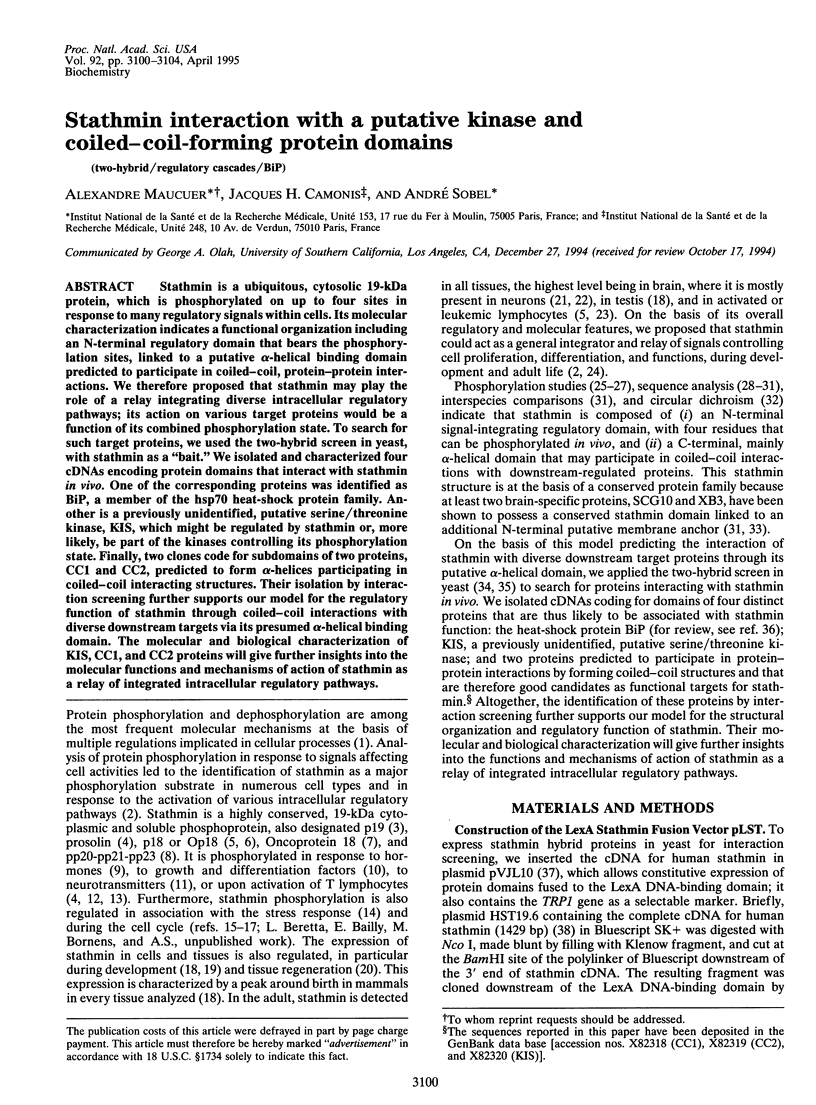
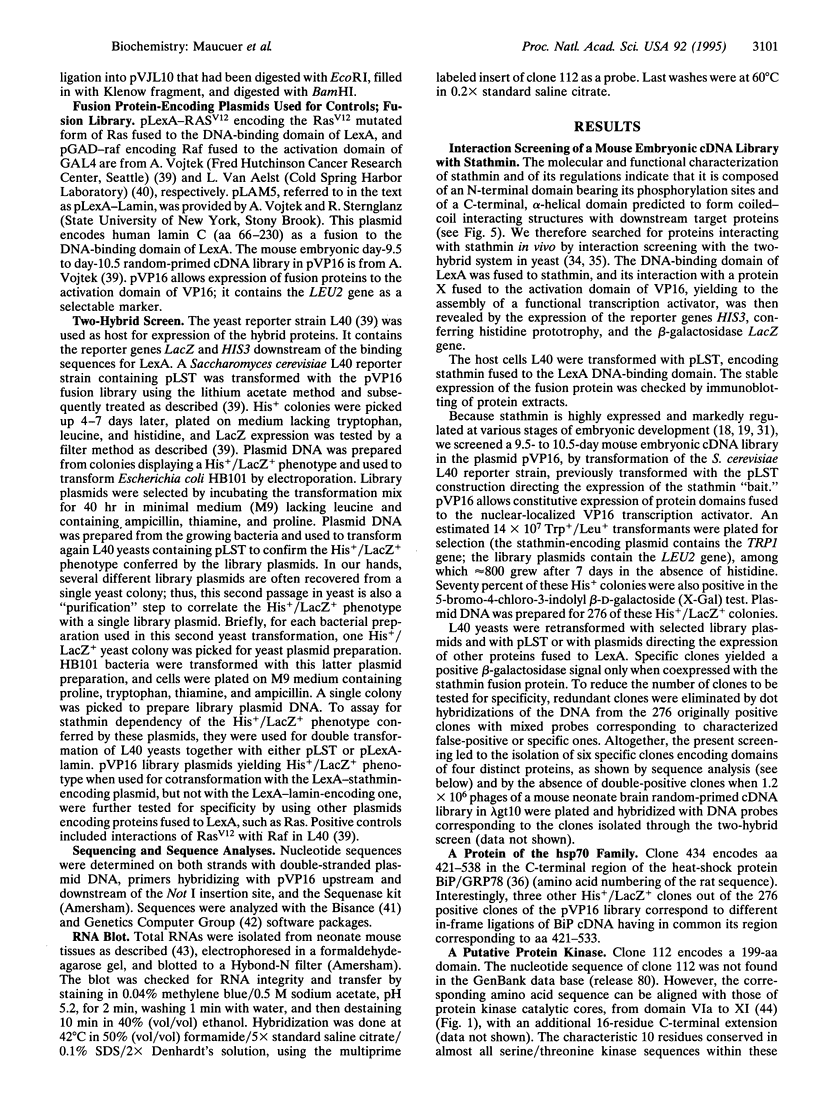
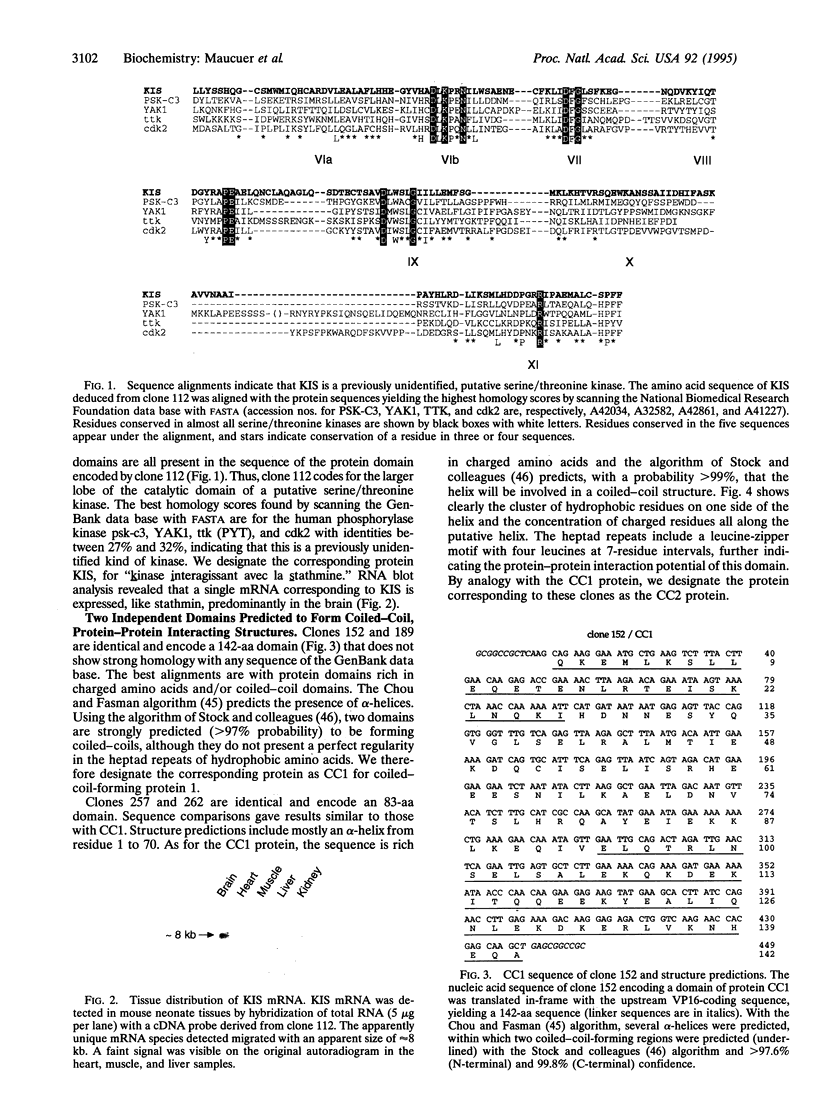
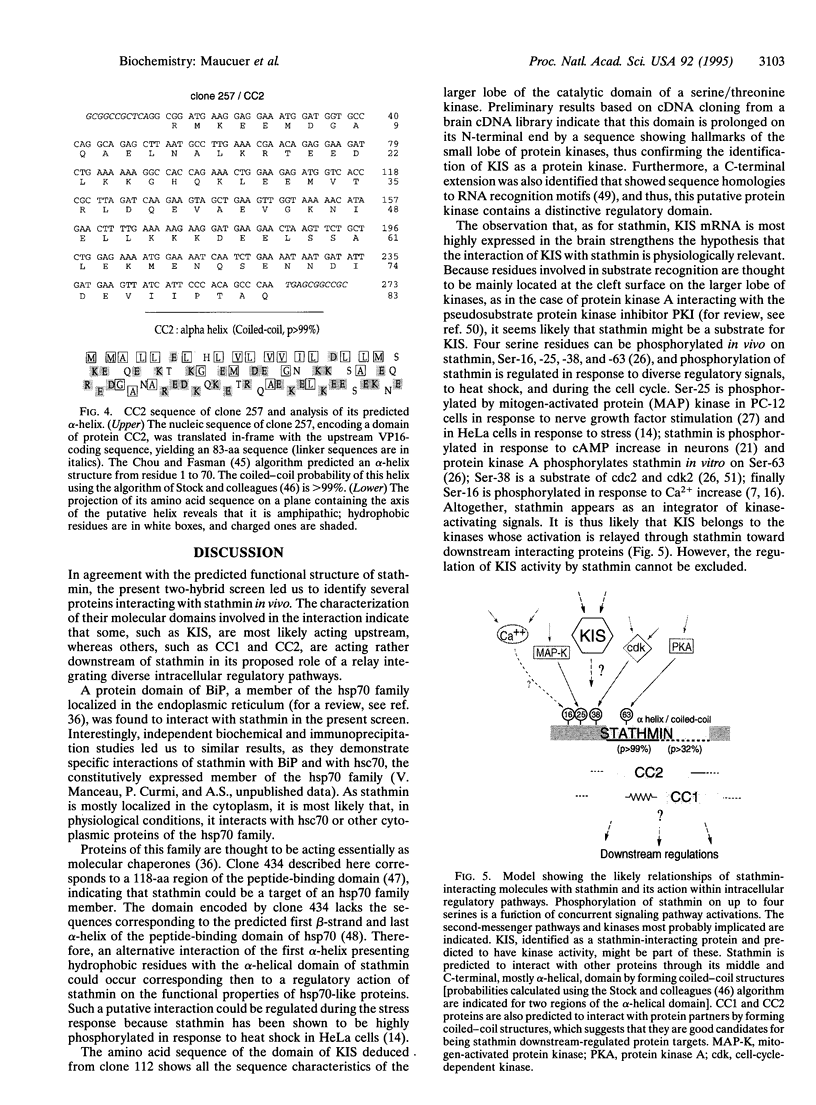
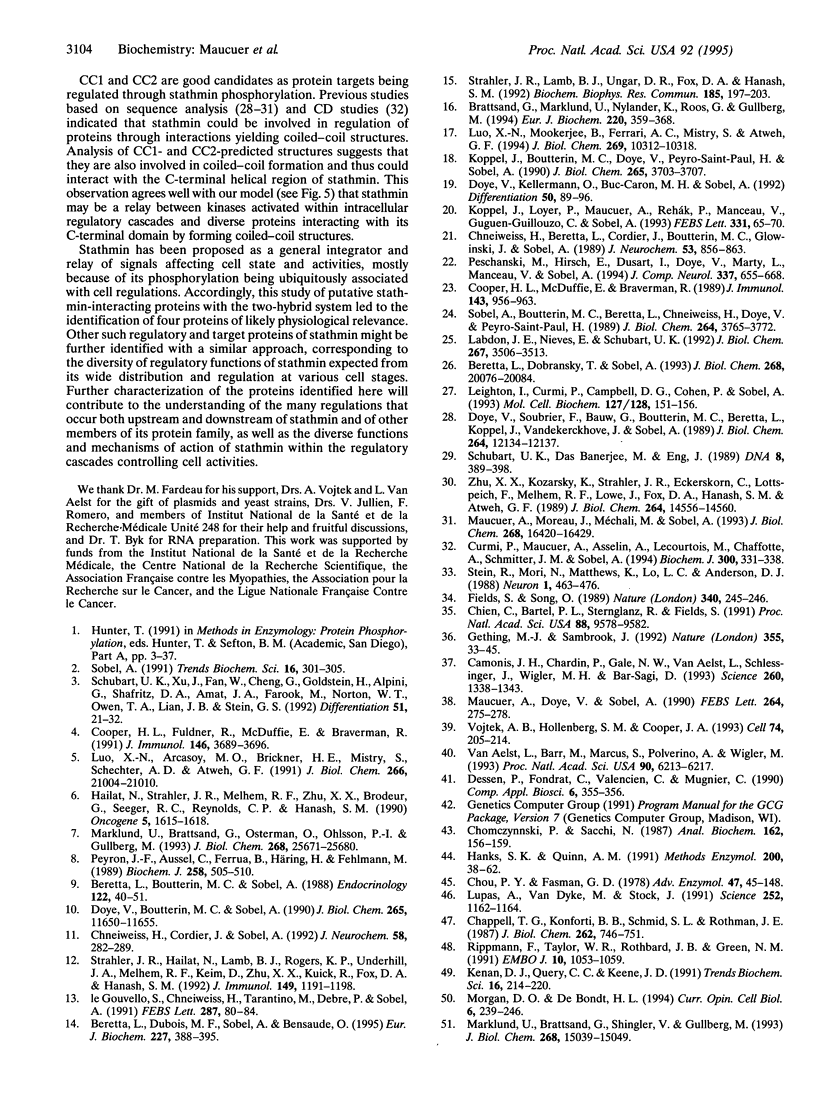
Images in this article
Selected References
These references are in PubMed. This may not be the complete list of references from this article.
- Beretta L., Boutterin M. C., Sobel A. Phosphorylation of intracellular proteins related to the multihormonal regulation of prolactin: comparison of normal anterior pituitary cells in culture with the tumor-derived GH cell lines. Endocrinology. 1988 Jan;122(1):40–51. doi: 10.1210/endo-122-1-40. [DOI] [PubMed] [Google Scholar]
- Beretta L., Dobránsky T., Sobel A. Multiple phosphorylation of stathmin. Identification of four sites phosphorylated in intact cells and in vitro by cyclic AMP-dependent protein kinase and p34cdc2. J Biol Chem. 1993 Sep 25;268(27):20076–20084. [PubMed] [Google Scholar]
- Beretta L., Dubois M. F., Sobel A., Bensaude O. Stathmin is a major substrate for mitogen-activated protein kinase during heat shock and chemical stress in HeLa cells. Eur J Biochem. 1995 Jan 15;227(1-2):388–395. doi: 10.1111/j.1432-1033.1995.tb20401.x. [DOI] [PubMed] [Google Scholar]
- Brattsand G., Marklund U., Nylander K., Roos G., Gullberg M. Cell-cycle-regulated phosphorylation of oncoprotein 18 on Ser16, Ser25 and Ser38. Eur J Biochem. 1994 Mar 1;220(2):359–368. doi: 10.1111/j.1432-1033.1994.tb18632.x. [DOI] [PubMed] [Google Scholar]
- Chappell T. G., Konforti B. B., Schmid S. L., Rothman J. E. The ATPase core of a clathrin uncoating protein. J Biol Chem. 1987 Jan 15;262(2):746–751. [PubMed] [Google Scholar]
- Chardin P., Camonis J. H., Gale N. W., van Aelst L., Schlessinger J., Wigler M. H., Bar-Sagi D. Human Sos1: a guanine nucleotide exchange factor for Ras that binds to GRB2. Science. 1993 May 28;260(5112):1338–1343. doi: 10.1126/science.8493579. [DOI] [PubMed] [Google Scholar]
- Chien C. T., Bartel P. L., Sternglanz R., Fields S. The two-hybrid system: a method to identify and clone genes for proteins that interact with a protein of interest. Proc Natl Acad Sci U S A. 1991 Nov 1;88(21):9578–9582. doi: 10.1073/pnas.88.21.9578. [DOI] [PMC free article] [PubMed] [Google Scholar]
- Chneiweiss H., Beretta L., Cordier J., Boutterin M. C., Glowinski J., Sobel A. Stathmin is a major phosphoprotein and cyclic AMP-dependent protein kinase substrate in mouse brain neurons but not in astrocytes in culture: regulation during ontogenesis. J Neurochem. 1989 Sep;53(3):856–863. doi: 10.1111/j.1471-4159.1989.tb11783.x. [DOI] [PubMed] [Google Scholar]
- Chneiweiss H., Cordier J., Sobel A. Stathmin phosphorylation is regulated in striatal neurons by vasoactive intestinal peptide and monoamines via multiple intracellular pathways. J Neurochem. 1992 Jan;58(1):282–289. doi: 10.1111/j.1471-4159.1992.tb09308.x. [DOI] [PubMed] [Google Scholar]
- Chomczynski P., Sacchi N. Single-step method of RNA isolation by acid guanidinium thiocyanate-phenol-chloroform extraction. Anal Biochem. 1987 Apr;162(1):156–159. doi: 10.1006/abio.1987.9999. [DOI] [PubMed] [Google Scholar]
- Chou P. Y., Fasman G. D. Prediction of the secondary structure of proteins from their amino acid sequence. Adv Enzymol Relat Areas Mol Biol. 1978;47:45–148. doi: 10.1002/9780470122921.ch2. [DOI] [PubMed] [Google Scholar]
- Cooper H. L., Fuldner R., McDuffie E., Braverman R. T cell receptor activation induces rapid phosphorylation of prosolin, which mediates down-regulation of DNA synthesis in proliferating peripheral lymphocytes. J Immunol. 1991 Jun 1;146(11):3689–3696. [PubMed] [Google Scholar]
- Cooper H. L., McDuffie E., Braverman R. Human peripheral lymphocyte growth regulation and response to phorbol esters is linked to synthesis and phosphorylation of the cytosolic protein, prosolin. J Immunol. 1989 Aug 1;143(3):956–963. [PubMed] [Google Scholar]
- Curmi P. A., Maucuer A., Asselin S., Lecourtois M., Chaffotte A., Schmitter J. M., Sobel A. Molecular characterization of human stathmin expressed in Escherichia coli: site-directed mutagenesis of two phosphorylatable serines (Ser-25 and Ser-63). Biochem J. 1994 Jun 1;300(Pt 2):331–338. doi: 10.1042/bj3000331. [DOI] [PMC free article] [PubMed] [Google Scholar]
- Dessen P., Fondrat C., Valencien C., Mugnier C. BISANCE: a French service for access to biomolecular sequence databases. Comput Appl Biosci. 1990 Oct;6(4):355–356. doi: 10.1093/bioinformatics/6.4.355. [DOI] [PubMed] [Google Scholar]
- Doye V., Boutterin M. C., Sobel A. Phosphorylation of stathmin and other proteins related to nerve growth factor-induced regulation of PC12 cells. J Biol Chem. 1990 Jul 15;265(20):11650–11655. [PubMed] [Google Scholar]
- Doye V., Kellermann O., Buc-Caron M. H., Sobel A. High expression of stathmin in multipotential teratocarcinoma and normal embryonic cells versus their early differentiated derivatives. Differentiation. 1992 Jun;50(2):89–96. doi: 10.1111/j.1432-0436.1992.tb00489.x. [DOI] [PubMed] [Google Scholar]
- Doye V., Soubrier F., Bauw G., Boutterin M. C., Beretta L., Koppel J., Vandekerckhove J., Sobel A. A single cDNA encodes two isoforms of stathmin, a developmentally regulated neuron-enriched phosphoprotein. J Biol Chem. 1989 Jul 25;264(21):12134–12137. [PubMed] [Google Scholar]
- Fields S., Song O. A novel genetic system to detect protein-protein interactions. Nature. 1989 Jul 20;340(6230):245–246. doi: 10.1038/340245a0. [DOI] [PubMed] [Google Scholar]
- Gething M. J., Sambrook J. Protein folding in the cell. Nature. 1992 Jan 2;355(6355):33–45. doi: 10.1038/355033a0. [DOI] [PubMed] [Google Scholar]
- Hailat N., Strahler J., Melhem R., Zhu X. X., Brodeur G., Seeger R. C., Reynolds C. P., Hanash S. N-myc gene amplification in neuroblastoma is associated with altered phosphorylation of a proliferation related polypeptide (Op18). Oncogene. 1990 Nov;5(11):1615–1618. [PubMed] [Google Scholar]
- Hanks S. K., Quinn A. M. Protein kinase catalytic domain sequence database: identification of conserved features of primary structure and classification of family members. Methods Enzymol. 1991;200:38–62. doi: 10.1016/0076-6879(91)00126-h. [DOI] [PubMed] [Google Scholar]
- Kenan D. J., Query C. C., Keene J. D. RNA recognition: towards identifying determinants of specificity. Trends Biochem Sci. 1991 Jun;16(6):214–220. doi: 10.1016/0968-0004(91)90088-d. [DOI] [PubMed] [Google Scholar]
- Koppel J., Boutterin M. C., Doye V., Peyro-Saint-Paul H., Sobel A. Developmental tissue expression and phylogenetic conservation of stathmin, a phosphoprotein associated with cell regulations. J Biol Chem. 1990 Mar 5;265(7):3703–3707. [PubMed] [Google Scholar]
- Koppel J., Loyer P., Maucuer A., Rehák P., Manceau V., Guguen-Guillouzo C., Sobel A. Induction of stathmin expression during liver regeneration. FEBS Lett. 1993 Sep 27;331(1-2):65–70. doi: 10.1016/0014-5793(93)80298-9. [DOI] [PubMed] [Google Scholar]
- Labdon J. E., Nieves E., Schubart U. K. Analysis of phosphoprotein p19 by liquid chromatography/mass spectrometry. Identification of two proline-directed serine phosphorylation sites and a blocked amino terminus. J Biol Chem. 1992 Feb 15;267(5):3506–3513. [PubMed] [Google Scholar]
- Leighton I. A., Curmi P., Campbell D. G., Cohen P., Sobel A. The phosphorylation of stathmin by MAP kinase. Mol Cell Biochem. 1993 Nov;127-128:151–156. doi: 10.1007/BF01076766. [DOI] [PubMed] [Google Scholar]
- Luo X. N., Arcasoy M. O., Brickner H. E., Mistry S., Schechter A. D., Atweh G. F. Regulated expression of p18, a major phosphoprotein of leukemic cells. J Biol Chem. 1991 Nov 5;266(31):21004–21010. [PubMed] [Google Scholar]
- Luo X. N., Mookerjee B., Ferrari A., Mistry S., Atweh G. F. Regulation of phosphoprotein p18 in leukemic cells. Cell cycle regulated phosphorylation by p34cdc2 kinase. J Biol Chem. 1994 Apr 8;269(14):10312–10318. [PubMed] [Google Scholar]
- Lupas A., Van Dyke M., Stock J. Predicting coiled coils from protein sequences. Science. 1991 May 24;252(5009):1162–1164. doi: 10.1126/science.252.5009.1162. [DOI] [PubMed] [Google Scholar]
- Marklund U., Brattsand G., Osterman O., Ohlsson P. I., Gullberg M. Multiple signal transduction pathways induce phosphorylation of serines 16, 25, and 38 of oncoprotein 18 in T lymphocytes. J Biol Chem. 1993 Dec 5;268(34):25671–25680. [PubMed] [Google Scholar]
- Marklund U., Brattsand G., Shingler V., Gullberg M. Serine 25 of oncoprotein 18 is a major cytosolic target for the mitogen-activated protein kinase. J Biol Chem. 1993 Jul 15;268(20):15039–15047. [PubMed] [Google Scholar]
- Maucuer A., Doye V., Sobel A. A single amino acid difference distinguishes the human and the rat sequences of stathmin, a ubiquitous intracellular phosphoprotein associated with cell regulations. FEBS Lett. 1990 May 21;264(2):275–278. doi: 10.1016/0014-5793(90)80266-l. [DOI] [PubMed] [Google Scholar]
- Maucuer A., Moreau J., Méchali M., Sobel A. Stathmin gene family: phylogenetic conservation and developmental regulation in Xenopus. J Biol Chem. 1993 Aug 5;268(22):16420–16429. [PubMed] [Google Scholar]
- Morgan D. O., De Bondt H. L. Protein kinase regulation: insights from crystal structure analysis. Curr Opin Cell Biol. 1994 Apr;6(2):239–246. doi: 10.1016/0955-0674(94)90142-2. [DOI] [PubMed] [Google Scholar]
- Peschanski M., Hirsch E., Dusart I., Doye V., Marty S., Manceau V., Sobel A. Stathmin: cellular localization of a major phosphoprotein in the adult rat and human CNS. J Comp Neurol. 1993 Nov 22;337(4):655–668. doi: 10.1002/cne.903370410. [DOI] [PubMed] [Google Scholar]
- Peyron J. F., Aussel C., Ferrua B., Häring H., Fehlmann M. Phosphorylation of two cytosolic proteins. An early event of T-cell activation. Biochem J. 1989 Mar 1;258(2):505–510. doi: 10.1042/bj2580505. [DOI] [PMC free article] [PubMed] [Google Scholar]
- Rippmann F., Taylor W. R., Rothbard J. B., Green N. M. A hypothetical model for the peptide binding domain of hsp70 based on the peptide binding domain of HLA. EMBO J. 1991 May;10(5):1053–1059. doi: 10.1002/j.1460-2075.1991.tb08044.x. [DOI] [PMC free article] [PubMed] [Google Scholar]
- Schubart U. K., Banerjee M. D., Eng J. Homology between the cDNAs encoding phosphoprotein p19 and SCG10 reveals a novel mammalian gene family preferentially expressed in developing brain. DNA. 1989 Jul-Aug;8(6):389–398. doi: 10.1089/dna.1.1989.8.389. [DOI] [PubMed] [Google Scholar]
- Schubart U. K., Xu J., Fan W., Cheng G., Goldstein H., Alpini G., Shafritz D. A., Amat J. A., Farooq M., Norton W. T. Widespread differentiation stage-specific expression of the gene encoding phosphoprotein p19 (metablastin) in mammalian cells. Differentiation. 1992 Sep;51(1):21–32. doi: 10.1111/j.1432-0436.1992.tb00676.x. [DOI] [PubMed] [Google Scholar]
- Sobel A., Boutterin M. C., Beretta L., Chneiweiss H., Doye V., Peyro-Saint-Paul H. Intracellular substrates for extracellular signaling. Characterization of a ubiquitous, neuron-enriched phosphoprotein (stathmin). J Biol Chem. 1989 Mar 5;264(7):3765–3772. [PubMed] [Google Scholar]
- Sobel A. Stathmin: a relay phosphoprotein for multiple signal transduction? Trends Biochem Sci. 1991 Aug;16(8):301–305. doi: 10.1016/0968-0004(91)90123-d. [DOI] [PubMed] [Google Scholar]
- Stein R., Mori N., Matthews K., Lo L. C., Anderson D. J. The NGF-inducible SCG10 mRNA encodes a novel membrane-bound protein present in growth cones and abundant in developing neurons. Neuron. 1988 Aug;1(6):463–476. doi: 10.1016/0896-6273(88)90177-8. [DOI] [PubMed] [Google Scholar]
- Strahler J. R., Hailat N., Lamb B. J., Rogers K. P., Underhill J. A., Melhem R. F., Keim D. R., Zhu X., Kuick R. D., Fox D. A. Activation of resting peripheral blood lymphocytes through the T cell receptor induces rapid phosphorylation of Op18. J Immunol. 1992 Aug 15;149(4):1191–1198. [PubMed] [Google Scholar]
- Strahler J. R., Lamb B. J., Ungar D. R., Fox D. A., Hanash S. M. Cell cycle progression is associated with distinct patterns of phosphorylation of Op18. Biochem Biophys Res Commun. 1992 May 29;185(1):197–203. doi: 10.1016/s0006-291x(05)80975-1. [DOI] [PubMed] [Google Scholar]
- Van Aelst L., Barr M., Marcus S., Polverino A., Wigler M. Complex formation between RAS and RAF and other protein kinases. Proc Natl Acad Sci U S A. 1993 Jul 1;90(13):6213–6217. doi: 10.1073/pnas.90.13.6213. [DOI] [PMC free article] [PubMed] [Google Scholar]
- Vojtek A. B., Hollenberg S. M., Cooper J. A. Mammalian Ras interacts directly with the serine/threonine kinase Raf. Cell. 1993 Jul 16;74(1):205–214. doi: 10.1016/0092-8674(93)90307-c. [DOI] [PubMed] [Google Scholar]
- Zhu X. X., Kozarsky K., Strahler J. R., Eckerskorn C., Lottspeich F., Melhem R., Lowe J., Fox D. A., Hanash S. M., Atweh G. F. Molecular cloning of a novel human leukemia-associated gene. Evidence of conservation in animal species. J Biol Chem. 1989 Aug 25;264(24):14556–14560. [PubMed] [Google Scholar]
- le Gouvello S., Chneiweiss H., Tarantino N., Debre P., Sobel A. Stathmin phosphorylation patterns discriminate between distinct transduction pathways of human T lymphocyte activation through CD2 triggering. FEBS Lett. 1991 Aug 5;287(1-2):80–84. doi: 10.1016/0014-5793(91)80020-4. [DOI] [PubMed] [Google Scholar]




